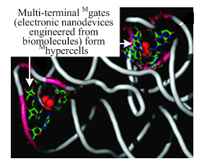

Department of Electrical Engineering, Rochester Institute of Technology, Rochester, NY 14623-5603, U.S.A., and
Air Force Research Laboratory, Information Technology Directorate, Rome, NY 13441, U.S.A.
e-mail: Sergey.Lyshevski@rit.edu

 |
 |
Sergey E. Lyshevski and Thomas Renz
Department of Electrical Engineering, Rochester Institute of Technology, Rochester, NY 14623-5603, U.S.A., and e-mail: Sergey.Lyshevski@rit.edu |
 |
This paper concentrates on devising of novel super-high-performance carbon-centered electronic nanodevices and their aggregation for logics and memories. These electronic devices can be synthesized from atoms and molecules by mimicking, to some extent, biosystems. Significant attention is concentrated on basic physics of molecular complexes. Fundamentals must be supported by technology, and it is shown that carbon molecular technology is based on sound physics and chemistry. Quantum mechanics is used to examine envisioned electronic devices and their performance. Bottom-up nanotechnology allows one to fabricate electronic devices with the desired structures utilizing chemical synthesis, deposition, functionalization and other processes. Performance and characteristics of electronic nanodevices are drastically influenced by the atomic (molecular) structures, aggregation, bonds, atomic orbitals, electron affinity, ionized potential, arrangement, sequence, assembly and other features. We focus our efforts on design of nanodevices and their aggregates that ensure practical electronic characteristics and superior performance. In particular, super-high bandwidth (switching frequency), superior density, super-low power, multi-valued I–V characteristics, enhanced functionality, noise immunity, robustness and other characteristics can be ensured through a coherent design. Performance and characteristics can be changed and optimized by altering and controlling quantum processes in three-dimensional atomic complexes that form interconnected nanodevices. For example, number of quantum wells, barriers width, energy profile, tunneling length, propagation path, dielectric constant and other features can be adjusted and optimized by designing atomic complexes with controlled atomic sequences, bonds, branches, etc. The goal is to ensure optimal achievable performance and assess it using the performance evaluation matrices. We report viable results in synthesis, design and analyze of novel electronic nanodevices and their functional aggregates.